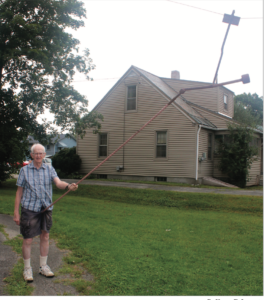By Karen D. Lorentz
Editor’s note: This is part three in a three-part series on former ski areas in Vermont.
“Not the Biggest, But One of The Best” was the slogan the late Bill Jenkins came up with for the High Pond Ski Area, which opened to the public in winter 1951.
High Pond was built as a personal ski area for W. Douglas Burden, a wealthy entrepreneur who had made his fortune in mining and other businesses, on a 500-acre farm he owned. His friends had wanted to ski there, too, so he hired Jenkins and Stan Whitney to operate it on weekends and holidays. Jenkins was teaching skiing at Green Mountain College during the week.

The late Bill Jenkins demonstrated the Stabil Lift he built with friend Stan Whitney in his yard in Rutland. Such inventions allowed for local areas to succeed.
Jenkins described the hill as having “a 300-foot vertical—similar to Pico’s Triple Slope area—an ideal hill.” There were five slopes (later eight) that served all ability levels and a short, slow beginner rope tow below the base lodge that kids loved, he told me in a 2012 interview.
On the main hill, there was a second rope tow and a Bridger Manufacturing Platterpull lift, which was later replaced by a Dopplemayr T-bar.
Jenkins installed one of the first Larchmont snowmakers there for the 1952 season, recalling it was an “experimental system and not very successful; we took it out after one season.”
Jenkins also taught skiing while Whitney ran the High Pond Inn with his wife Joan and Bill’s wife Nancy. [Nancy Jenkins was also the manager of the Pico Ski Shop for many years.] They catered to guests from all over, including ski clubs that arrived by bus.
Located in Hubbardton, High Pond became known as a family area. Jenkins left High Pond in 1958 when his schedule of ski teaching and coaching racers went to seven days a week at Green Mountain College. High Pond was operated by Larry Wheeler and then the Livak family for 18 years through the winter of 1975. It also had a sliding/tobogganing hill and hosted some Otter Valley Winter Carnivals. High Pond operated on and off into the early/mid 1980s with John and Sherry Armitage operating it in 1983 and 1984. The area is now privately owned.
John Tower, who learned to ski there (1963-1967), recalled that a school bus would pick kids up in Brandon and another in Pittsford and drop them off at the area for Saturday recreational skiing. “We could ski and buy lunch for $5,” he said. He recalled it was a very popular area, noting, “there were lots of kids and it could get pretty crowded.”
Birdseye Ski Area
Jenkins started planning the Birdseye Ski Area on the Castleton/Ira town line in 1958 with a group of local investors. His original idea was to have “a self-sustaining operation, so I proposed building a summer theme park to help finance winter operations. But I was known as a skier so they pushed for the ski area,” he said.
“We built a Stabil Disc lift that Stan Whitney and I had designed. It was like a Pomalift but the retraction device worked by gravity so there wasn’t a snap when you let go of the flexible tube [pole].”
The mountain debuted in 1962 with a 750-foot Stabil lift on the west side, a rope tow, open slope, and trails. “Two years later we installed a 500-foot disc lift on the north face and three more trails. A 1,300-foot Doppelmayr T-bar was installed above that lift [1965] for 500 feet of vertical. There were plans to go to the top with chairlifts to offer a 1,300-foot vertical.
“We installed 10 Larchmont snowguns which worked very well. This was the third Larchmont system in Vermont. I wanted snowmaking for each lift area because the area wasn’t in a snowbelt and we had unlimited water from the Castleton River. But the board of directors installed the T-bar without snowmaking, so I resigned. That turned out to be a low snow year, and the area only operated two more years,” Jenkins said.
The area closed in 1968 but had had “a very successful night skiing” operation and later was used for a campground for a time.
While competition from larger ski areas hurt the smaller areas that were still operating after the 1950s ski boom, it was really the lack of snowmaking and the cost of liability insurance that finally “killed off many of them” in the 1970s and early 1980s, Jenkins said. But not before launching many a youngster and adult into a fun-filled winter sport that was “just great for families,” he noted.
Vermont saw a significant decrease from a high of 81 areas in 1966 (including chairlift and surface lift /rope-tow areas) to 49 in 1978 and 39 in 1988. The state’s rope tows decreased from 65 in 1961 to 19 in 1988. By the 1988-89 season there were just 20 public ski areas operating with chairlifts. Today, there are 17 areas with chairlifts and just eight surface lift and/or rope-tow areas operating in Vermont. There are also a few private tows serving kids and families.
As one of the most influential ski instructors you never heard of, Bill Jenkins’ legacy was to be a significant part of early ski history and passing on a love for the sport over several generations that have made skiing an economic driver in Vermont. He also taught at other areas, including Pico and Okemo and continued to teach adaptive students at Pico into his 80s. He died on May 25, 2015 at age 90.




